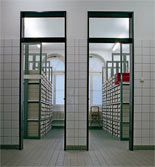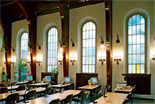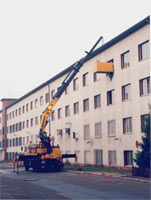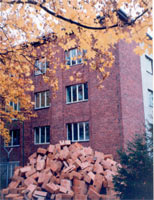
On 27 August 1994, the Bundesarchiv (Federal Archives) were given approximately one third of the Andrews' Barracks grounds. Excluded from this transaction were the indoor swimming pool, which belongs to the City-State of Berlin, as well as the former hospital,which a branch of the Institute for History and a department of the Federal Building Office moved into. The southern part of the grounds was sold to the Frankfurter Siedlungsgesellschaft (Frankfurter Community Development Group).
The grounds were fitting for a new archive location because its facilities offered a quick solution for the temporary storage of newly acquired material by the Bundesarchiv in Berlin during the time of the unification, and because its site had the potential for future building expansion.
History of the Federal Archives
Founding of the Reich Archives in Potsdam as a central archive for civilian as well as military and administrative files of the German Reich since 1867
» 1924
Completion of the Frankfurt Am Main branch for archival material from the German Federation and the Reichskammergerichts (Supreme Court of the Reich)
» 1935
Founding of the Reich Film Archives in Berlin
» 1936
Exclusion of the Army Archives from the Reich Archives
» 1945
Extensive damage to the Army and Air Force Archives as well as the SS Archives, and the confiscation of extensive archival material by the Allied troops. Much of this material was later either traced back to the Soviet Union and returned to the GDR, or traced back to the USA, Great Britain and France and returned to the Federal Republic of Germany
The Federal Republic of Germany
Completion of the Federal Archives in Koblenz on 3 June 1952
» 1954
Incorporation of the Frankfurt branch of the Reich Archives, founded in 1924, into the Federal Archives
» 1968
Relocation of the Military Archives Department, created in 1955, to Freiburg
» 1974
Opening of the memorial exhibition "Freedom Movements in German History", in Rastatt
» 1986
Opening of the new Federal Archives building in Koblenz-Karthause
» 1986
Establishment of the Lastenausgleicharchiv in Bayreuth (according to the law regarding the central archiving of material concerning the consequences of the WWII and its pertaining laws)
German Reunification 1990
Merger of the Federal Archives with the central archives of the GDR: The Central State Archives and Military Archives in Potsdam, the State Film Archives in Berlin
» 1992
Establishment of the Foundation on Archives of Parties and Mass Organizations of the GDR (SAPMO) in the Federal Archives, located in Berlin
» 1994
Relinquishing of their command over the Berlin Document Center by the Americans
» 1995-96
Consolidation of archival material from 26 locations in Berlin, Brandenburg and Saxony-Anhalt, to Berlin-Lichterfelde
» 1997
Establishment of the temporary archives for German higher federal authorities, in Hoppergarten near Berlin
» 2000
Transfer of the documents of the Zentrale Stelle (ZSt - "Central Location") for the investigation of Nazi war crimes to the new branch office in Ludwigsburg
Personal, archival and library material from 26 discontinued departments and archive locations in the Berlin-Brandenburg and Saxony-Anhalt regions were brought together in the Finckensteinallee location. SAPMO moved into this location as well in late summer 1995. By 1996 the Reich and GDR departments of the former State Archives and the former Berlin Document Center were also relocated to Berlin-Lichterfelde.
The only remaining buildings from the time of the Kadettenanstalt (Building 903) and the facilities building (Building 906), which was refurbished during the time of the Nazis, currently serve as storage areas. In Building 901 there are two reading rooms, workshops and employee offices. In the former Andrews' Chapel there is a library reading room.
Through the merging of many different departments, the Berlin-Lichterfelde location has become the largest facility of the Bundesarchiv. Approximately 90 kilometers of archival material from circa 2,000 inventoried pieces (excluding privately protected personal material) from the Reich and GDR departments as well as from SAPMO can be viewed here without a waiting period so long as person privacy rights are respected. Additionally there are 1.7 million books, newspapers, magazines and other printed material available.
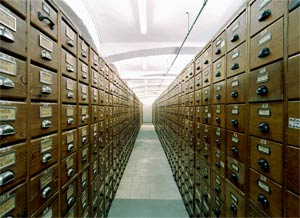
Membership card catalog from the NSDAP (Nazi party) in original boxes with 11 million membership cards.

Foyer in Building 903 from the times of the Hauptkadettenanstalt (Cadet's Institute) being used as a storage facility.
After the end of the German Democratic Republic and the beginning of reunified Germany, the jurisdiction of the Bundesarchiv was expanded in accordance with the Unification Treaty to include the archives of the former GDR. Many pieces of German archival material that were separated at the end of the Second World War could finally be brought back together. The former Central States Archives of the GDR, which contained extensive archival material from the earlier Reichs Archives, were moved into the Bundesarchiv, as were the Potsdamer Military Archives, the State Film Archives of the GDR, and the Photo Archives of the ADN - Allgemeinen Deutschen Nachrichtendienstes (Public German News Service - the official news agency of East Germany).
Soviet Zone of Occupation (SBZ) / The German Democratic Republic
Founding of the German Central Archives in Potsdam for material rescued from the former Reich Archives
» 1955
Founding of the State Film Archives in Berlin
» 1964
Completion of the Military Archives of the GDR in Potsdam
» 1973
Renaming of the German Central Archives in Potsdam to "The Central State Archives"
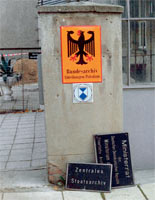
Changing of the nameplate plaque at the entrance of the Central State Archives on Tizianstraße in Potsdam.
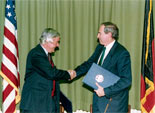
Dr. Wilhelm Schürmann (on the left) of the German Federal Foreign Office and Principal Officer Douglas H. Jones of the US State Department after signing the German-American intergovernmental agreement.
For the holdings of the SED (the United Socialist Party of [East] Germany), other party factions and the mass organizations of the GDR, the Foundation on Archives of Parties and Mass Organizations of the GDR (SAPMO) was officially founded in Berlin. On 18 October 1993, the USA and the Federal Republic of Germany reached an agreement that the NSDAP (Nazi) material which had been held in the Berlin Document Center be handed over to the Bundesarchiv and remain in Berlin.
